⑩-2 Silent Manipulation (Frozen Shoulder)
We would like to introduce a treatment called “Silent Manipulation.”
Simply put, it is a manipulation procedure performed in an outpatient setting under anesthesia, allowing the patient to feel little to no pain while improving the shoulder’s range of motion.
Indication:
Refractory frozen shoulder (a severe form of adhesive capsulitis).
Let me explain what this treatment involves.
Specific Details:
- Testimonials from patients who have undergone Silent Manipulation
- Outcomes of Silent Manipulation (in other words, our clinical evidence)
This method has also been introduced on YouTube by Dr. Wataru Iwamoto from Edogawa Hospital. Dr. Iwamoto is a close colleague of mine. Please refer to his video as well.
https://www.youtube.com/watch?v=fmOMbr_fOzQ
Testimonial from a patient who underwent Silent Manipulation
I'm about to undergo a treatment called "Silent Manipulation," which is also featured on YouTube.
I’ve heard that they’ll use anesthesia so I won’t feel pain, and then work to improve my shoulder’s range of motion.
I’ve done a lot of research—watched YouTube videos and read information online.
Since my shoulder hardly moves at all, I’ve decided to give it a try.
Doctor: "Now, I’m going to inject the anesthetic around the nerve while watching it with ultrasound."
Me: "The injection in my neck doesn’t hurt much... Oh, it’s already done."
Doctor: "We’ll wait about 10 minutes for the anesthesia to take effect. Once you lose sensation, we’ll start moving your shoulder."
Ten minutes later
Doctor: “You don’t feel even cold sensations around your shoulder anymore, right? Okay, let’s begin.”
The doctor grabs my arm and starts moving it in various directions.
Me: “Wow, it doesn’t hurt… Hmm, maybe just a little bit of pain now.”
Doctor: “The anesthesia is working. This procedure wouldn't be possible without it, so don’t worry.”
Me: “It feels strange. It seems like my shoulder is moving, but I can’t feel it. Wait, I just heard a weird sound. What part of this is ‘silent’?”
Doctor: “‘Silent’ refers to how quiet the procedure is. That sound you heard was the joint capsule tearing. Compared to the traditional manipulation technique, the noise is much softer—hence the name ‘Silent Manipulation.’ Now, we’re done. Look—your hand can now reach behind your back and over your head. You couldn’t do that before.”
Me: “Wow… You’re holding my arm, but I can tell my hand is touching the other shoulder—and I can feel it touching my back too. This is such a strange feeling…”
Doctor: “Alright, that’s the end of the procedure. Let’s work hard on your rehab from here.”
One week later
I can now do things I couldn’t before, like washing my hair and reaching for things up high.
I really wish I had undergone this treatment sooner.
Now, I feel like there’s a light at the end of the tunnel—as long as I keep working hard on rehab, I believe I can fully recover.
This is a testimonial from a patient who underwent a procedure called Silent Manipulation, performed for cases where frozen shoulder has progressed into a refractory contracture.
It’s completely natural to feel anxious before receiving treatment.
That’s why I hope more people become aware of this option.
Mechanism and Evidence of Silent Manipulation
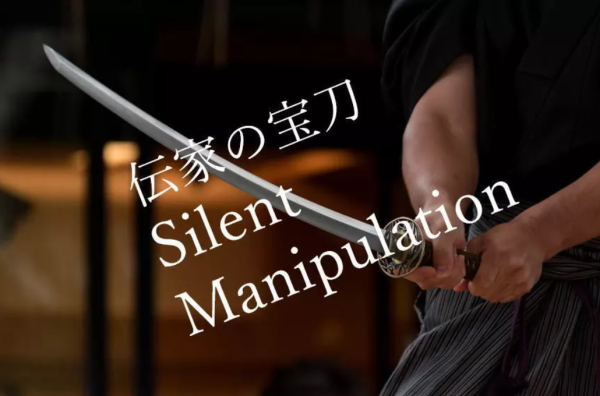
We believe that the treatments introduced so far can adequately manage pain, including nighttime pain.
However, there are two groups of patients: those whose fibrotic joint capsule naturally recovers with inflammation control, resulting in improved range of motion, and those who do not regain their range of motion.
For the latter group, Silent Manipulation can be considered the ultimate solution to restore mobility.
First, anesthesia is administered.
Under ultrasound guidance, a local anesthetic is injected around the nerve root.
Since the opening of our clinic, we have already performed approximately 100 manipulation procedures.
Let me show you the actual Silent Manipulation procedure.
The nerve block is performed using 10–15 mL of 1% carbocaine.
We inject 5 mL each at C5 and C6, and a small amount is also injected at C7.
While pain relief of the joint itself is achieved with the C5 and C6 block, during the actual procedure the latissimus dorsi and triceps muscles are also stretched, which can cause pain. The block at C7 helps control this pain.
In the past, there was a patient whose pain was not relieved by a C6–7 block but was successfully managed by extending the block to C8. We believe this was due to involvement of the thoracodorsal nerve, which innervates the latissimus dorsi muscle, running at the C8 level.
Reference:
- Latissimus dorsi: Thoracodorsal nerve (C6–8)
- Triceps brachii: Radial nerve (C7)
- Teres major: Lower subscapular nerve (C5–7)
Start of shoulder joint manipulation after anesthesia administration
Post-procedure
Progression of Silent Manipulation
Here, we present the evidence.
We will share the results of a comparative study between cases treated with Silent Manipulation (SM) and those treated with conservative therapy (CT), which includes physical therapy and range of motion training.
Results
Results: Basic Characteristics of the Participants
| SM group (14Sample14 Shoulder) | CT group (33Sample34 Shoulder) |
P value | ||
| Age | (years) | 53.6±0.2 | 54.7±0.2 | >0.05 |
| Gender | Male | 4Shoulder | 8Shoulder | >0.05 |
| Female | 10Shoulder | 26Shoulder |
Results: Progression of Range of Motion in the SM Group and CT Group
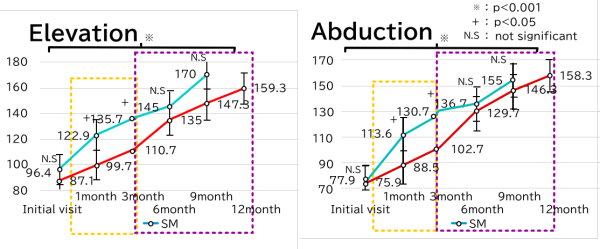
Within-group comparison:
Significant changes over time in range of motion were observed.
There were s
Results: Progression of Range of Motion in the SM and CT Groups
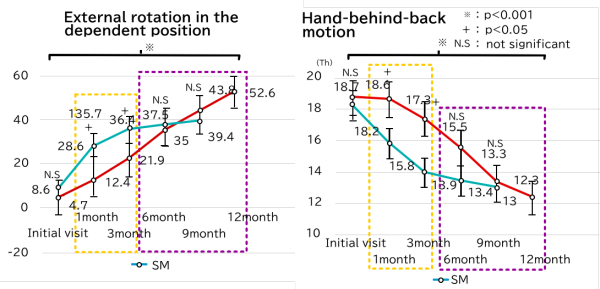
Within-group comparison:
Significant changes over time in range of motion were observed.
There were s
Results: SM Group vs. CT Group at Final Follow-up
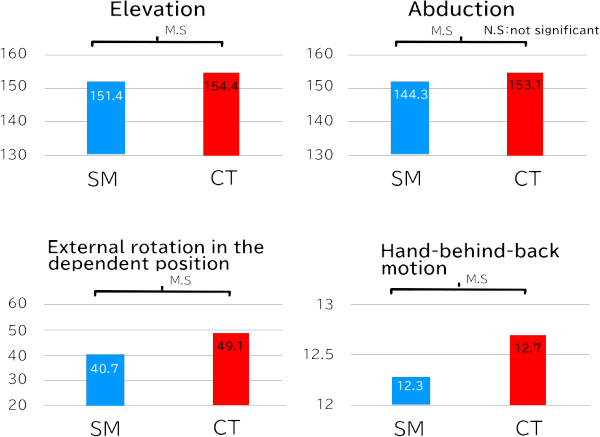
Results: SM Group vs. CT Group
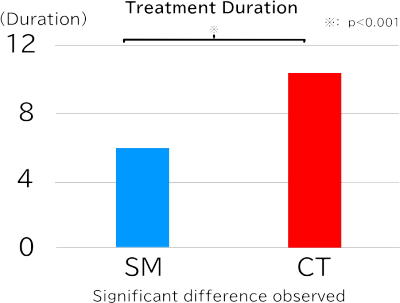
Conclusion
SM: Enables early recovery of range of motion and shortens the treatment period.
CT: With long-term treatment, it is possible to achieve a range of motion comparable to that of SM.
The final attained range of motion is similar between SM and CT.
Both treatments can provide stable outcomes tailored to the patient's needs.
Additional notes on this study:
- Patients in the SM group requested SM treatment from their first visit to our clinic.
- The degree of pain was not evaluated.
- The SM group did not include patients with diabetes, who are prone to developing refractory contractures.
Summary:
- We explained what Silent Manipulation is.
- It is one of the effective treatments for refractory contracture.
Shoulder Diseases

We provide explanations for various shoulder conditions. Please use this as a general guide to determine which condition may apply to you.
- Common shoulder injuries by age group
- To those who neither have frozen shoulder nor rotator cuff tears
- Throwing Shoulder Disorder
- Rotator Cuff Tears and Rotator Cuff Injuries
- Recurrent Shoulder Dislocation
- Frozen Shoulder
- Shoulder Dislocation
- Acromioclavicular Joint Dislocation
- Chronic Acromioclavicular Joint Dislocation
- Frozen Shoulder
- Calcific Tendinitis of the Rotator Cuff
- Primary Degenerative Shoulder Arthritis
- Rotator Cuff Tear-related Degenerative Shoulder Arthritis
- Non-traumatic Shoulder Instability
- Biceps Tendon Injuries
- Surgical Trends for Throwing Shoulder in Baseball Players
